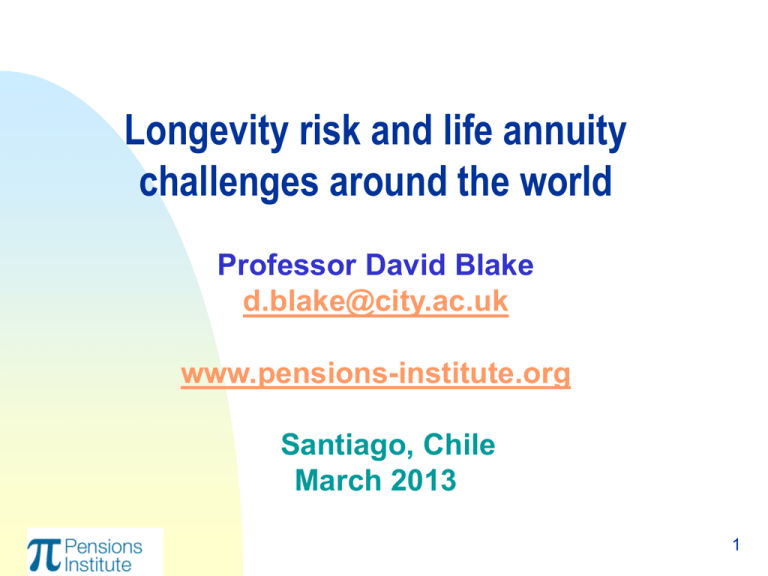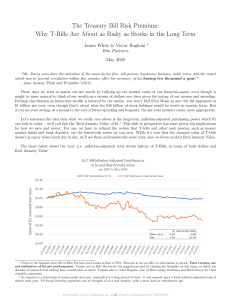Financial and Monetary Economics
Anuncio

Longevity risk and life annuity challenges around the world Professor David Blake [email protected] www.pensions-institute.org Santiago, Chile March 2013 1 Agenda Longevity and other retirement risks Current retirement income products How retirement income products can be improved Insurance firm solvency and risk-based capital Challenges for annuities and longevity risk A role for government in longevity risk sharing? Conclusions 2 Longevity and other retirement risks 3 Income needs in retirement are not smooth or certain POST TAX INCOME ACTIVE RETIREMENT PASSIVE RETIREMENT I N ? HE N R U I R H T S O A I M N N E C G E INHERITANCE AGE 4 Risks in retirement Interest rate risk: when annuity is purchased Inflation risk Investment and reinvestment risk Longevity risk: outliving leaving failure resources unintended bequests to leave intended bequests Morbidity or care risk Pensioners have limited understanding of these risks 5 Variability in life expectancy 5 Life expectancy = 86.6 4 Most likely age at death = 90 3 2 1 25% 25% Random Variation Risk Random Variation Idiosyncratic risk 10 Most likely age at death = 86 Life expectancy = 91.6 9 8 7 6 1 in 3 will reach 93 and 5% will reach 100 Idiosyncratic risk 5 4 3 2 1 Risk 0 Expected distribution of deaths: male 85 % deaths at each age % deaths at each age Expected distribution of deaths: male 65 65 70 75 80 85 90 95 100 105 110 Age 1 in 1000 chance of living twice life expectancy at age 65 0 85 90 95 Age 100 105 1 in 10 chance of living twice life expectancy at age 85 Source: 100% PNMA00 medium cohort 2007 6 The challenge is huge: Individuals consistently underestimate how long they will live... Age INDIVIDUAL UNDERESTIMATES OF LIFE EXPECTANCY BY AGE 20-29 30-39 40-49 50-59 60-69 Men Women 0 10 2 4 6 8 Number of years by which consumers underestimate life expectancy Sources: O’Brian, Fenn, and Diacon, 2005, self-estimated life expectancy compared with GAD forecast life expectancy; own analysis. 7 Current retirement income products: Annuities and phased withdrawal 8 The lifetime income guarantee provided by an annuity is funded by investment growth, the annuitant’s own capital and the capital released by those dying early Expected composition of each annuity payment for a male aged 65 purchasing an annuity for £100,000 providing an income of £7,773 payable at the end of each year to all annuitants still alive. ANNUITY WITH NO DEATH BENEFIT MALE 65 - £7,773 £ 8000 7000 6000 5000 4000 3000 2000 1000 AGE 0 65 70 75 80 Growth less charges 85 Capital 90 95 100 105 110 Cross-Subsidy Source: Own analysis using 100% PNMA00 medium cohort 2007 9 In the early years, investment growth is the most significant constituent of the income payment and cross-subsidy is small Limited cross-subsidy ANNUITY £7,773 NO DEATH BENEFIT MALE 65 £ 8000 7000 6000 5000 4000 3000 2000 1000 AGE 0 65 70 75 80 Growth less charges Investment growth significant 85 Capital 90 95 100 105 110 Cross-Subsidy Source: Own analysis using 100% PNMA00 medium cohort 2007 10 The lifetime income guarantee provided by an annuity is funded by the capital released by those dying early The funds of those dying in a year are spread over the lives surviving. ANNUITY £7,773 Significant cross-subsidy NO DEATH BENEFIT MALE 65 Limited cross-subsidy £ 8000 7000 6000 5000 4000 3000 2000 1000 AGE 0 65 70 75 80 Growth less charges 85 Capital 90 95 100 105 110 Cross-Subsidy Source: Own analysis using 100% PNMA00 medium cohort 2007 11 At age 85 the cross-subsidy provides half of the guaranteed income and continues to grow in significance £ ANNUITY £20,401 NO DEATH BENEFIT MALE 85 25000 20000 15000 10000 5000 0 85 90 95 100 105 110 AGE Growth Capital Cross-Subsidy Source: Own analysis using 100% PNMA00 medium cohort 2007 12 If retirees continue to use phased withdrawal from age 85, many will run out of money Male aged 85 with £100,000 fund taking £20,000 per annum exhausts fund by life expectancy of 91.6 years … but 50% will live longer than this Fund £ 100000 80000 % age still alive 100% 90% 80% 70% 60% 50% 40% 30% 20% 10% 0% 50% will outlive their assets 60000 40000 20000 0 85 90 %age still alive 95 100 105 £20,000pa with 5% return Source: Own analysis using 100% PNMA00 medium cohort 2007 and £100,000 fund 13 Reducing income taken and increased investment returns have little impact on the erosion of the fund at older ages Male aged 85 with £100,000 fund taking £16,000 per annum exhausts fund by age 94 … 33% will outlive their assets … even with growth of 6.5% Fund £ 100000 %age still alive 100% 90% 80% 70% 60% 50% 40% 30% 20% 10% 0% 80000 33% will outlive their assets 60000 40000 20000 0 85 90 %age still alive 95 100 £20,000 5% 105 £16,000 6.5% return Source: Own analysis using 100% PNMA00 medium cohort 2007 and £100,000 fund 14 An annuity is the best option for most of the mass market Most pensioners have limited means Mass market households are likely to have to accept a relatively simple strategy with default options Primary focus on maximising retirement income Reliance on State and any housing equity for providing for health care and other retirement contingencies Bequests typically left more by chance mainly in form of residual housing equity 15 Optimisation for the mass affluent is very complex Optimisation is an extremely difficult task for pensioners in their 60s looking forward to retirements of 20 years or more Very difficult task to optimise controlled run down of pensioner’s assets throughout retirement Pensioners have varying needs and face many risks Many pensioners have not focused on many of these risks: makes optimisation difficult Optimal solutions are likely to differ: because each set of needs and risks differ 16 As life expectancy reduces optimisation becomes easier Fortunately as people get older, optimisation task becomes easier: fewer risks around investment considerations become easier when people go into nursing home income expenditure become less volatile Phased withdrawal Pension annuities Equity release There is a narrowing funnel of doubt Rainy day based on life expectancy fund Immediate needs annuity Non-pension annuities Insurance 17 How retirement income products can be improved 18 Issues to take into account People need reassurance that it pays to save Pension death benefits are generous for phased withdrawal – not for annuities Phasing into annuitization may be more acceptable Annuity products with equity linking might be valuable for those who are sufficiently risk tolerant 19 Money-back or capital-protected annuity Any pooling of mortality needs to be perceived to be fair by the public: Currently, this is not true! At younger ages, annuity mortality cross-subsidy gives poor value to those dying early Money-back or capital-protected annuity: Removes single biggest consumer objection to annuities: “If I die soon after I retire, the annuity provider will keep my fund” 20 Money-back or capital-protected annuity CAPITAL PROTECTED ANNUITY MALE 65 INCOME £7,222 ANNUITY NO DEATH BENEFIT Death Ben £ MALE 65 INCOME £7,773 Income £ p.a. Income £ p.a. 100000 8000 8000 £551 p.a. = Cost of death benefit 90000 7000 7000 80000 6000 6000 70000 5000 60000 4000 50000 5000 4000 40000 3000 3000 30000 2000 2000 20000 1000 10000 0 0 65 70 75 80 85 90 95 100 105 1000 0 65 70 75 80 85 90 95 AGE 100 AGE Growth less charges Capital Cross-Subsidy Death Benefit Source: Own analysis using 100% PNMA00 medium cohort 2007 21 US-style variable annuity GMAB – guaranteed minimum accumulation benefit Guaranteed minimum fund at end of accumulation phase GMDB – guaranteed minimum death benefit Guaranteed minimum fund on death of insured GMIB – guaranteed minimum income benefit e.g. ‘five for life’ but < annuity and higher charges, e.g. 60bp for 5% guarantee when VA was offering ‘5 for life’, fixed annuity was offering ‘7.5 for life’ GMWB – guaranteed minimum withdrawal benefit guaranteed minimum amount from fund on periodic basis, regardless of fund performance if for life, then equivalent to GMIB 22 Other new product ideas Advanced life deferred annuity (ALDA) An annuity that begins paying after a significant deferral period, e.g. 20 or 30 years Life care annuity An income annuity that pays an increased benefit if the purchaser needs care 23 Insurance firm solvency and risk-based capital 24 Solvency II (2014) Three pillar approach in EU (same as Basel II): Pillar 1: Minimum capital charges will apply to: Standard Model or Internal Risk Based (IRB) Model to determine regulatory capital: aim to bring regulatory capital closer to economic capital Pillar 2 Supervisory pillar underwriting, credit, market and operational risks operates ‘ladder of intervention’ between SCR and MCR Pillar 3 Market discipline through greater information disclosure 25 Solvency II (2014) Solvency Capital Requirement (SCR) Set as minimum capital to attract S&P BBB rating: ‘has good financial security characteristics, but is more likely to be affected by adverse business conditions than are higher rated insurers’ Equiv to 99.5% probability that insurer survives one year i.e., can experience a single 1-in-200 year negative event and still meet all its liabilities to policyholders Minimum Capital Requirement (MCR) Minimum level of regulatory capital needed Below this supervisor will order suspension of new business or winding up of whole firm unless firm offers credible recovery plan 26 Challenges for annuities and longevity risk 27 Population aged 60 or over: World and development regions, 1950-2050 Source: World Population Ageing: 1950-2050 (United Nations) 28 Potential support ratio: World and development regions, 1950-2050 Source: World Population Ageing: 1950-2050 (United Nations) 29 Total support ratio (TSR) and economic growth Ratio of the number of workers to the number of both young and old people High TSR is typically associated with rapid economic growth Cf China, India and Korea In Japan, TSR peaked in 1992 and its economy has been fairly static since 30 Support ratios in Japan Source: Fig. A2 in Mayhew (2009) 31 Relationship between growth rate in GDP and changes in TSR in Japan Source: Fig. A3 in Mayhew (2009) 32 Implications of an ageing population Living standards likely to fall in some countries with fast-ageing populations: GDP growth in EU and Japan could fall from 2% to 1% pa US likely to escape this fall Higher growth rates in countries with slower ageing populations More volatile stock markets due to more flexible labour markets As capital flows to economies with higher returns Lower real interest rates Investment demand falls with a smaller population by more than savings falls? 33 FTSE100 Index 1985-2012 8000 7000 6000 5000 4000 3000 Increasingly volatile stock markets 2000 1000 1/85 1/1990 1/1995 1/2000 1/2005 1/2010 1/2015 34 Implications for pension products Fixed annuities Increasing longevity, low interest rates, and SII seriously reduce payments: SII reduces payments by up to 20% Phased withdrawal and investment-linked annuities: Increasingly volatile stock markets lead to increasingly volatile payments Mitigated by a smoothing fund 35 A role for government in longevity risk sharing? 36 Longevity fan chart for 65-year old male (Cairns-Blake-Dowd model) 37 Mortality fan charts (CBD model) 38 Survivor fan chart for 65-year-old male (CBD model) 100 SURVIVOR RATE % AGE 75 80 60 AGE 90 40 20 0 AGE Expected value 90% confidence 39 Decomposition of longevity risk Total longevity risk = Aggregate longevity risk [Trend risk] + Specific longevity risk Government hedges [Idiosyncratic and modelling risks] Private sector hedges 40 Longevity volatility driven by threeby underlying … Longevity riskis is driven threerisks underlying risks Outcome probability, % Expected Outcome A B C Alternative Outcome Modelling Risk Trend Risk Idiosyncratic Risk A Modelling Risk: Risk that probability distribution is incorrectly modelled due to a limited data set. B Trend Risk: Risk that large unanticipated changes in socio economic environment or health care significantly improve longevity. C Idiosyncratic Risk: Risk that mortality rates still vary from the expected outcome as a result of random chance. Life expectancy Modelling Risk and Idiosyncratic (Random Variation) Risk are greater the smaller the number of scheme members and the greater the distribution of scheme benefits. 41 Potential role for government in helping to hedge longevity risk PAYMENT Tail risk longevity bond from age 90 with terminal payment at 100 to cover post-100 longevity risk 100 80 Capital markets deal with this segment in long run 60 Govt. earns longevity risk premium TERMINAL PAYMENT 40 20 0 AGE Expected value 90% confidence 42 Longevity bond cash flows across ages and time YEAR 2045 2040 Issue year of bond 2035 Deferment period on bond 2030 Payments on bond 2025 2020 2015 2010 65 70 75 80 85 90 95 100 1945 1940 1935 1930 1925 1920 1915 1910 AGE BIRTH YEAR 43 Conclusions Limited ability to hedge interest rate, inflation and investment risks long term: We will have to cope with living in an increasingly volatile financial world Hedging longevity risk becomes THE single most important consideration: Essential at the level of the individual Feasible at the macro level with longevity bonds 44 Conclusions Annuities can be improved: Capital protection Smoothing fund Deferred annuities Linking to care costs But too much regulatory capital and we kill the goose that lays the golden egg! Also high charges can lead to significant consumer detriment 45 But it’s if not when to annuitise Annual mortality cross subsidy 20% 15% Limited value from annuitization – Death benefit seen as more valuable. Annuitization essential to provide income for life 10% 5% 0% AGE 46 Thank you! Longevity 10: Tenth International Longevity Risk and Capital Markets Solutions Conference September 2014 Santiago, Chile www.longevity-risk.org 47


